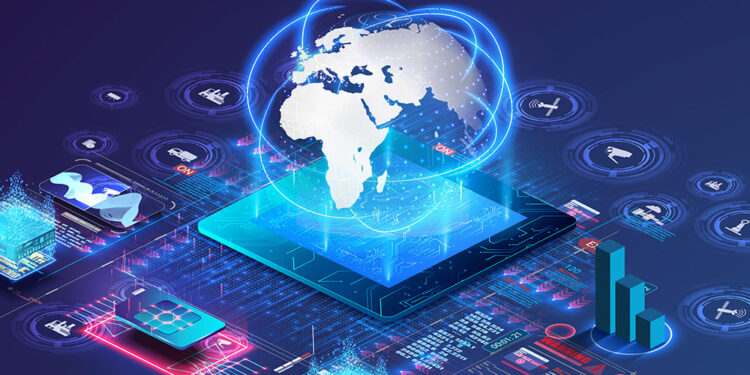Embarking on the journey of DigiLife Technology Trends in Digital Infrastructure, we delve into a realm where innovation and connectivity converge to shape the future of digital landscapes. As businesses navigate the evolving technological terrain, understanding the key components and implications of these trends becomes paramount for sustainable growth and success.
Exploring the intricate interplay between technology and infrastructure, we uncover the transformative power of DigiLife Technology in redefining the way we perceive and interact with digital systems.
Overview of DigiLife Technology Trends in Digital Infrastructure

DigiLife Technology encompasses the utilization of digital solutions and innovations to enhance the efficiency and effectiveness of various aspects of our lives. In the context of digital infrastructure, DigiLife Technology refers to the integration of advanced technologies to support and optimize the digital framework that enables communication, data storage, and seamless connectivity.
Key Components of Digital Infrastructure within DigiLife Technology
- Cloud Computing: The utilization of remote servers hosted on the internet to store, manage, and process data, providing scalable resources and on-demand access.
- 5G Networks: The next generation of wireless technology that offers faster data speeds, increased bandwidth, and low latency, facilitating the connectivity of various devices and applications.
- Internet of Things (IoT): The interconnected network of devices, sensors, and systems that communicate and exchange data to automate processes and enhance efficiency.
- Cybersecurity Measures: Implementing protocols and technologies to protect digital infrastructure from potential cyber threats and unauthorized access.
Significance of Staying Updated with Technology Trends in Digital Infrastructure for Businesses
Businesses that stay abreast of technology trends in digital infrastructure are better positioned to adapt to the evolving digital landscape, improve operational efficiency, and enhance customer experiences. By leveraging innovative digital solutions, organizations can streamline processes, reduce costs, and gain a competitive edge in the market.
Impact of Artificial Intelligence (AI) on Digital Infrastructure

Artificial Intelligence (AI) is playing a transformative role in revolutionizing digital infrastructure in the era of DigiLife Technology. With its capabilities to analyze vast amounts of data, identify patterns, and make intelligent decisions in real-time, AI is enhancing the efficiency and reliability of digital infrastructure across various industries.
Enhanced Data Analysis and Predictive Maintenance
AI-powered systems are enabling more advanced data analysis techniques, allowing organizations to extract valuable insights from their data at a much faster pace. By leveraging machine learning algorithms, AI can predict potential issues in digital infrastructure before they occur, enabling proactive maintenance to prevent costly downtime.
Automation and Optimization
AI-driven automation is streamlining processes within digital infrastructure, reducing human intervention and minimizing errors. Through smart algorithms, AI can optimize resource allocation, improve network performance, and enhance overall system scalability. This automation leads to higher operational efficiency and cost savings.
Performance and Scalability Comparison
When comparing traditional digital infrastructure with AI-powered systems, the difference in performance and scalability is evident. AI systems can handle complex tasks with greater speed and accuracy, adapting to changing demands in real-time. This agility allows digital infrastructure to scale seamlessly to accommodate growing data volumes and user requirements, ensuring a more resilient and responsive network.
Internet of Things (IoT) Integration in Digital Infrastructure
The integration of Internet of Things (IoT) devices plays a crucial role in shaping modern digital infrastructure strategies under DigiLife Technology. IoT devices are interconnected smart gadgets that collect and exchange data over the internet, enabling seamless communication and automation in various processes.
Role of IoT Devices in Digital Infrastructure
IoT devices are instrumental in optimizing digital infrastructure operations by providing real-time data insights for better decision-making. For example, smart sensors can monitor equipment performance, energy consumption, and environmental conditions, allowing for predictive maintenance and resource optimization.
Examples of IoT Applications
- Smart Building Management Systems: IoT sensors can regulate lighting, temperature, and security systems in buildings, enhancing energy efficiency and occupant comfort.
- Asset Tracking: IoT-enabled tags can monitor the location and condition of assets in real-time, streamlining inventory management and supply chain operations.
- Smart Grids: IoT devices can monitor electricity usage, detect faults, and optimize distribution, leading to more reliable and sustainable energy infrastructure.
Challenges and Opportunities
- Challenges:
- Security Concerns: IoT devices may pose cybersecurity risks if not properly secured, potentially exposing sensitive data to malicious attacks.
- Interoperability Issues: Integrating diverse IoT devices from different manufacturers can be complex, requiring standardized protocols for seamless communication.
- Opportunities:
- Data-driven Insights: IoT data analytics can uncover valuable patterns and trends, enabling proactive decision-making and operational efficiency.
- Enhanced Connectivity: IoT integration fosters interconnected systems, enabling automation, remote monitoring, and improved service delivery.
Cloud Computing and Its Influence on Digital Infrastructure

Cloud computing has revolutionized the way digital infrastructure operates, offering enhanced scalability and flexibility to organizations. By migrating digital infrastructure to cloud-based platforms, companies can experience numerous benefits that align with the goals of DigiLife Technology.
Impact on Scalability and Flexibility
- Cloud computing allows for easy scalability, enabling organizations to adjust resources based on demand fluctuations without the need for significant infrastructure changes.
- The flexibility offered by cloud-based platforms empowers businesses to quickly adapt to market changes and implement new technologies efficiently.
- This enhanced scalability and flexibility contribute to improved operational efficiency and cost-effectiveness in managing digital infrastructure.
Benefits of Migration to Cloud-Based Platforms
- Migrating to cloud-based platforms reduces the need for physical infrastructure, leading to cost savings in terms of hardware maintenance and upgrades.
- Cloud computing offers enhanced collaboration capabilities, enabling seamless communication and data sharing among team members across different locations.
- Access to advanced analytics and AI tools on cloud platforms enhances decision-making processes and drives innovation within organizations.
Addressing Security Concerns
- Security concerns related to cloud adoption in digital infrastructure include data breaches, compliance issues, and unauthorized access to sensitive information.
- Implementing robust encryption protocols and access controls can mitigate the risks associated with cloud security breaches.
- Regularly updating security measures, conducting thorough audits, and investing in training programs for employees can strengthen the overall security posture of cloud-based digital infrastructure.
Ending Remarks
In conclusion, the exploration of DigiLife Technology Trends in Digital Infrastructure illuminates the path towards a more efficient, secure, and adaptable digital ecosystem. By embracing these trends and harnessing their potential, businesses can position themselves at the forefront of technological evolution, driving innovation and competitiveness in the digital age.













